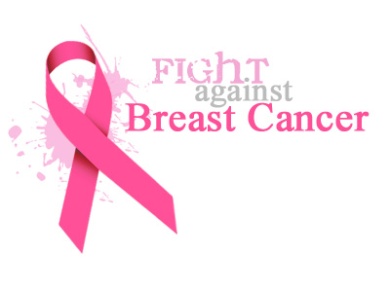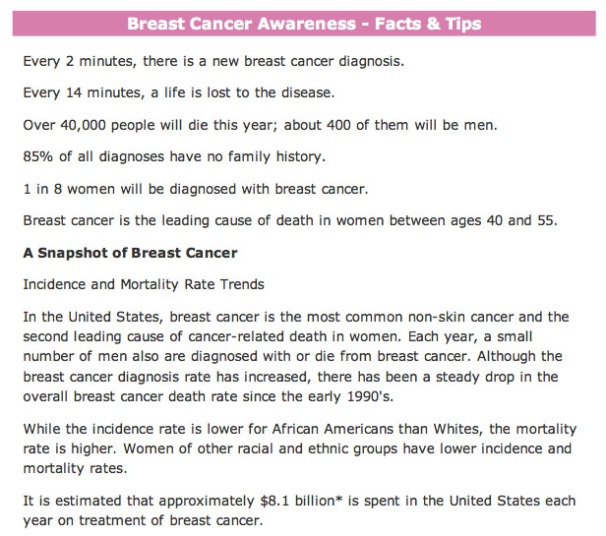Breast cancer is a disease in which malignant (cancer) cells form in the tissues of the breast.
The breast is made up of lobes and ducts. Each breast has 15 to 20 sections called lobes, which have many smaller sections called lobules. Lobules end in dozens of tiny bulbs that can produce milk. The lobes, lobules, and bulbs are linked by thin tubes called ducts.
Each breast also has blood vessels and lymph vessels. The lymph vessels carry an almost colorless fluid called lymph. Lymph vessels lead to organs called lymph nodes. Lymph nodes are small bean-shaped structures that are found throughout the body. They filter substances in lymph and help fight infection and disease. Clusters of lymph nodes are found near the breast in the axilla (under the arm), above the collarbone, and in the chest.
The most common type of breast cancer is ductal carcinoma, which begins in the cells of the ducts. Cancer that begins in the lobes or lobules is called lobular carcinoma and is more often found in both breasts than are other types of breast cancer. Inflammatory breast cancer is an uncommon type of breast cancer in which the breast is warm, red, and swollen.
Age and health history can affect the risk of developing breast cancer.
Anything that increases your chance of getting a disease is called a risk factor. Risk factors for breast cancer include the following:
- Older age.
- Menstruating at an early age.
- Older age at first birth or never having given birth.
- A personal history of breast cancer or benign (noncancer) breast disease.
- A mother or sister with breast cancer.
- Treatment with radiation therapy to the breast/chest.
- Breast tissue that is dense on a mammogram.
- Taking hormones such as estrogen and progesterone.
- Drinking alcoholic beverages.
- Being white.
Breast cancer is sometimes caused by inherited gene mutations (changes).
The genes in cells carry the hereditary information that is received from a person’s parents. Hereditary breast cancer makes up approximately 5% to 10% of all breast cancer. Some altered genes related to breast cancer are more common in certain ethnic groups.
Women who have an altered gene related to breast cancer and who have had breast cancer in one breast have an increased risk of developing breast cancer in the other breast. These women also have an increased risk of developing ovarian cancer, and may have an increased risk of developing other cancers. Men who have an altered gene related to breast cancer also have an increased risk of developing this disease. (For more information, refer to the PDQ summary onMale Breast Cancer Treatment.)
Tests have been developed that can detect altered genes. These genetic tests are sometimes done for members of families with a high risk of cancer. (Refer to the PDQ summaries on Screening for Breast Cancer, Prevention of Breast Cancer, andGenetics of Breast and Ovarian Cancer for more information.)
Tests that examine the breasts are used to detect (find) and diagnose breast cancer.
A doctor should be seen if changes in the breast are noticed. The following tests and procedures may be used:
- Mammogram: An x-ray of the breast.
- Biopsy: The removal of cells or tissues so they can be viewed under a microscope by a pathologist to check for signs of cancer. If a lump in the breast is found, the doctor may need to cut out a small piece of the lump. Four types of biopsies are as follows:
- Excisional biopsy: The removal of an entire lump or suspicious tissue.
- Incisional biopsy: The removal of part of a lump or suspicious tissue.
- Core biopsy: The removal of part of a lump or suspicious tissue using a wide needle.
- Needle biopsy or fine-needle aspiration biopsy: The removal of part of a lump, suspicious tissue, or fluid, using a thin needle.
- Estrogen and progesterone receptor test: A test to measure the amount of estrogen and progesterone (hormones) receptors in cancer tissue. If cancer is found in the breast, tissue from the tumor is examined in the laboratory to find out whether estrogen and progesterone could affect the way cancer grows. The test results show whether hormone therapy may stop the cancer from growing.
Certain factors affect prognosis (chance of recovery) and treatment options.
The prognosis (chance of recovery) and treatment options depend on the following:
- The stage of the cancer (whether it is in the breast only or has spread to lymph nodes or other places in the body).
- The type of breast cancer.
- Estrogen-receptor and progesterone-receptor levels in the tumor tissue.
- A woman’s age, general health, and menopausal status (whether a woman is still having menstrual periods).
- Whether the cancer has just been diagnosed or has recurred (come back).
1. Avoid becoming overweight. Obesity raises the risk of breast cancer after menopause, the time of life when breast cancer most often occurs. Avoid gaining weight over time, and try to maintain a body-mass index under 25 (calculators can be found online).
2. Eat healthy to avoid tipping the scale. Embrace a diet high in vegetables and fruit and low in sugared drinks, refined carbohydrates and fatty foods. Eat lean protein such as fish or chicken breast and eat red meat in moderation, if at all. Eat whole grains. Choose vegetable oils over animal fats.
3. Keep physically active. Research suggests that increased physical activity, even when begun later in life, reduces overall breast-cancer risk by about 10 percent to 30 percent. All it takes is moderate exercise like a 30-minute walk five days a week to get this protective effect.
4. Drink little or no alcohol. Alcohol use is associated with an increased risk of breast cancer. Women should limit intake to no more than one drink per day, regardless of the type of alcohol.
5. Avoid hormone replacement therapy. Menopausal hormone therapy increases risk for breast cancer. If you must take hormones to manage menopausal symptoms, avoid those that contain progesterone and limit their use to less than three years. “Bioidentical hormones” and hormonal creams and gels are no safer than prescription hormones and should also be avoided.
6. Consider taking an estrogen-blocking drug. Women with a family history of breast cancer or who are over age 60 should talk to their doctor about the pros and cons of estrogen-blocking drugs such as tamoxifen and raloxifene.
7. Consider taking the aromatase inhibitor exemestane. The results of a study released earlier this year showed that the drug exemestane reduced the risk of breast cancer by 65 percent in high-risk, postmenopausal women. Talk to your doctor about whether this may benefit you.
8. Don’t smoke. Research suggests that long-term smoking is associated with increased risk of breast cancer in some women.
9. Breast-feed your babies for as long as possible. Women who breast-feed their babies for at least a year in total have a reduced risk of developing breast cancer later.
10. Get fit and support breast cancer research at the same time. Regular physical activity is associated with a reduced risk of breast cancer. Ascend some of the world’s most breathtaking peaks while raising vital funds for and awareness of breast cancer research by participating in the Hutchinson Center’s annual Climb to Fight Breast Cancer.








 The webinar, titled
The webinar, titled  and they’re already in the Southeast. We know just reading those words will stress you out so we thought we’d pass along what we’ve heard as well as a few tips from folks who’ve already gone through this exercise.
and they’re already in the Southeast. We know just reading those words will stress you out so we thought we’d pass along what we’ve heard as well as a few tips from folks who’ve already gone through this exercise. patients under our provider number. This service is also offered at no charge to you for both the service and products not to mention our clinical support from our certified
patients under our provider number. This service is also offered at no charge to you for both the service and products not to mention our clinical support from our certified  take a step back due to reduced staff, postponed facility improvements and reduced therapy.
take a step back due to reduced staff, postponed facility improvements and reduced therapy. 





